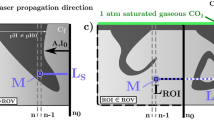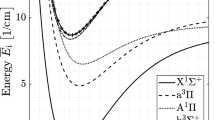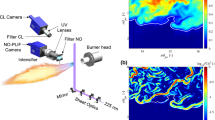Abstract
A planar laser-induced fluorescence (PLIF) data treatment taking into account variations of the fluorescence extinction due to pH is presented. It is shown that the proposed method needs to be implemented when the product of extinction coefficient variations, path length travelled by the laser and fluorescence concentration become large as in large tank experiments. The influence of extinction coefficient variations has been evaluated on CO2 concentration measurement for a test case in the wake of a free rising bubble.







Similar content being viewed by others
Abbreviations
- δ :
-
Diffusive length scale (m)
- \(\varepsilon\) :
-
Molar extinction coefficient \({\left(\frac{{\text{L}}}{{\text{mol m}}}\right)}\)
- ϕ :
-
Quantum yield of the fluorescence
- A :
-
Fraction of the available light collected
- A sc :
-
Area of a spherical cap bubble (m2)
- a :
-
Semi-width of a bubble, (m)
- C :
-
Carbon dioxide molar concentration \( \left( {\frac{{{\text{mol}}}}{{{\text{m}}^{3} }}} \right) \)
- c :
-
Fluorescein molar concentration \( \left( {\frac{{{\text{mol}}}}{{{\text{m}}^{3} }}} \right) \)
- e :
-
Thickness of the laser beam (mm)
- \(F_{{{\text{CO}}_{2} }}\) :
-
Molecular gas flux \(F_{{{\text{CO}}_{2} }} = K_{{L{\text{CO}}_{2} }} \times (C_{{{\text{sat}}}} - C_{{{\text{CO}}_{2} ({\text{aq}})}} )\;\left( {\frac{{{\text{mol}}}}{{{\text{sm}}^{2} }}} \right)\)
- h :
-
Length of the vertical sides of the region of interest (ROI) (m)
- I 0 :
-
Initial light intensity (U.A.)
- I e :
-
Laser excitation intensity (U.A.)
- I f :
-
Fluoresced intensity (U.A.)
- k dehyd :
-
Dehydration rate of H2CO3 (\(\frac{1}{s}\))
- k hyd :
-
Hydration rate of CO2 (aq) (\(\frac{1}{s}\))
- k l :
-
Mass transfer coefficient (\(\frac{\text{m}}{\text{s}}\))
- L d :
-
Distance between the diverging lens and the camera field of view (m)
- L fluo :
-
Distance traversed by the laser beam in the fluorescent fluid to reach the considered element of the ROI (m)
- L s :
-
Length of the sampling volume along the incident beams (m)
- L w :
-
Width of the camera field of view (m)
- r :
-
Coordinate in the downstream direction along a beam of light (m)
- V b :
-
Bubble rising velocity (\(\frac{\text{m}}{\text{s}}\))
- k :
-
Pixel column position along the laser beam
- l :
-
Pixel column position along the laser beam
- pH:
-
Value of the parameter for a given pH
- ref:
-
Value of the parameter for a reference pH before measurements
References
Asher W, Litchendorf T (2009) Visualizing near-surface concentration fluctuations using laser-induced fluorescence. Exp Fluids 46(2):243–253
Calderbank PH, Lochiel AC (1964) Mass transfer coefficients, velocities and shapes of carbon dioxide bubbles in free rise through distilled water. Chem Eng Sci 19(7):485–503
Clift R, Grace J, Weber M, Clift R (1978) Bubbles drops and particles, 3. Academic press, New York
Crimaldi J (2008) Planar laser induced fluorescence in aqueous flows. Exp Fluids 44(6):851–863
Dani A (2007) Transfert de masse entre une bulle et un liquide: simulations numériques directes et fluorescence induite par nappe laser. Thesis of Institut National des Sciences Appliquées (INSA) de Toulouse
Deshpande K, Zimmerman W (2006) Simulation of interfacial mass transfer by droplet dynamics using the level set method. Chem Eng Sci 61(19):6486–6498
Fdhila R, Duineveld P (1996) The effect of surfactant on the rise of a spherical bubble at high reynolds and peclet numbers. Phys Fluids 8:310
Feuerstein DL, Selleck RE (1963) Fluorescent tracers for dispersion measurements. J Sanit Eng Div Am Soc Civ Eng 89:1–21
Figueroa-Espinoza B, Legendre D (2010) Mass or heat transfer from spheroidal gas bubbles rising through a stationary liquid. Chem Eng Sci 65(23):6296–6309
Gibbons B, Edsall J (1963) Rate of hydration of carbon dioxide and dehydration of carbonic acid at 25 degrees. J Biol Chem 238:3502
Guilbault GG (1973) Practical fluorescence: theory, methods and techniques. M.Dekker, New York
Jirka G (2004) Application of LIF to investigate gas transfer near the air-water interface in a grid-stirred tank. Exp Fluids 37(3):341–349
Jirka G, Herlina H, Niepelt A (2010) Gas transfer at the air-water interface: experiments with different turbulence forcing mechanisms. Exp Fluids 49(1):319–327
Karasso P, Mungal M (1997) PLIF measurements in aqueous flows using the nd: YAG laser. Exp Fluids 23(5):382–387
Krishna R, Urseanu MI, Van Baten JM, Ellenberger J (1999) Wall effects on the rise of single gas bubbles in liquids. Int Commun Heat Mass Transf 26(6):781–790
Leonhardt H, Gordon L, Livingston R (1971) Acid-base equilibriums of fluorescein and 2′,7′-dichlorofluorescein in their ground and fluorescent states. J Phys Chem 75(2):245–249
Lindqvist L (1960) A flash photolysis of fluorescein. Arkiv for Kemi Band 16(nr 8):60
Melton L, Lipp C (2003) Criteria for quantitative PLIF experiments using high-power lasers. Exp Fluids 35(4):310–316
Roudet M (2008) Hydrodynamique et transfert de masse autour d’une bulle confinée entre deux plaques. Thesis of Institut National des Sciences Appliquées (INSA) de Toulouse
Sarathi P, Gurka R, Kopp G, Sullivan P (2012) A calibration scheme for quantitative concentration measurements using simultaneous PIV and PLIF. Exp Fluids 52(1):247
Simoens S, Ayrault M (1994) Concentration flux measurements of a scalar quantity in turbulent flows. Exp Fluids 16(3-4):273–281
Sjöback R, Nygren J, Kubista M (1995) Absorption and fluorescence properties of fluorescein. Spectrochim Acta Part A Mol Biomol Spectrosc 51(6):L7–L21
Stöhr M, Schanze J, Khalili A (2009) Visualization of gas-liquid mass transfer and wake structure of rising bubbles using pH-sensitive PLIF. Exp Fluids 47(1):135–143
Valiorgue P, Hajem MEl, Vassilev A, Botton V, Hadid HBen (2011) Elongated gas bubble dissolution under a turbulent liquid flow. Chem Eng Process Process Intensif 50(8):854–858
Variano EA, Cowen EA (2007) Quantitative imaging of CO2 transfer at an unsheared free surface. In: Garbe C, Handler R, Jöhne B (eds) Transport at the air-sea interface : measurements, models and parametrizations. Springer Verlag, New York
Walker D (1987) A fluorescence technique for measurement of concentration in mixing liquids. J Phys E: Sci Instrum 20:217
Wylock C, Larcy A, Colinet P, Cartage T, Haut B (2011) Direct numerical simulation of bubble-liquid mass transfer coupled with chemical reactions: influence of bubble shape and interface contamination. Colloids Surf A Physicochem Eng Aspects 381:130–138
Acknowledgments
The authors would like to thank Microphyt SAS for funding part of this research.
Author information
Authors and Affiliations
Corresponding author
Appendices
Appendix 1: Reaction time
As written in Gibbons and Edsall (1963) about CO2 reaction kinetics with water : “although the acid–base equilibrium is essentially instantaneous, the dehydration rate of H2CO3 is relatively slow" implying that time to reach equilibrium for H2CO3 and pH may not be short enough to track CO2 concentration variations [cited in Asher and Litchendorf (2009)]. The kinetic of H2CO3/CO2 reaction has been modeled with the coupled differential equations system (7) where k dehyd is the dehydration rate of H2CO3 and k hyd is the hydration rate of CO2.
In (Asher and Litchendorf 2009), the system has been solved analytically with Maple using the source term \(F_{{{\text{CO}}_{2} }}\)/δ (where \(F_{{{\text{CO}}_{2} }}\) is the molecular gas flux and δ is a diffusive length scale of CO2) considered as a constant and applied during a given time referred to here as exposure time.
In order to find the time for the reaction to reach equilibrium, the system has been solved using the same reaction rates values as in (Asher and Litchendorf 2009). Nevertheless, the initial condition of the CO2 spot has been changed in order to have a more realistic contact with the bubble : The source term \(F_{{{\text{CO}}_{2} }}\) /δ has been modeled as a function of time. It was a shifted cosine of maximum \(F_{{{\text{CO}}_{2} }}\)/δ with a semi-period equal to the exposure time requisite to reach the maximum concentration of CO2 in the wake of the bubble determined from Fig. 7.
It is shown in Fig. 8 that for the used continuous source term, [CO2] t=t_e − [CO2] t=0 is very close to the integral of the source term \(\int_0^{t_e} \frac{F_{\text{CO}_2}(t)}{\delta} dt\) meaning that for initial given concentrations, the corresponding concentration evolutions are mainly related to the evolution of the different source terms. Therefore, the time to reach equilibrium is very close to the exposure time (1 ms). The presented analysis suggests that the reaction has been fully completed between two frames (10 ms).
Appendix 2: Intensity attenuation due to the diverging lens
The decreasing intensity due to the diverging lens has to be corrected during the extinction coefficient variation calibration as a function of pH. Assuming no fluorescent dye and a constant thickness of the laser sheet, and considering light flux conservation, the ratio of intensities (per unit area) received by two pixel columns k and l can be determined geometrically :
where I k and I l are the light intensities received by the pixels of two pixel columns k and l, belonging to the ROI, of respective height h k and h l . L w is the width of the camera observation area, and L d is the distance between this area and the diverging lens, as shown in Fig. (4).
This contribution has been taken into account in Eq. (6). As it is a constant for any pair of pixel columns, it has no influence on the extinction coefficient variations (\(\varepsilon_{\text{ref}} - \varepsilon\)) as a function of pH.
Appendix 3: Data acquisition and data treatment procedures
The data acquisition and data treatment procedures from the acquired fluorescence signal to CO2 concentration maps are presented in the following Fig. 9.
Rights and permissions
About this article
Cite this article
Valiorgue, P., Souzy, N., Hajem, M.E. et al. Concentration measurement in the wake of a free rising bubble using planar laser-induced fluorescence (PLIF) with a calibration taking into account fluorescence extinction variations. Exp Fluids 54, 1501 (2013). https://doi.org/10.1007/s00348-013-1501-y
Received:
Revised:
Accepted:
Published:
DOI: https://doi.org/10.1007/s00348-013-1501-y






